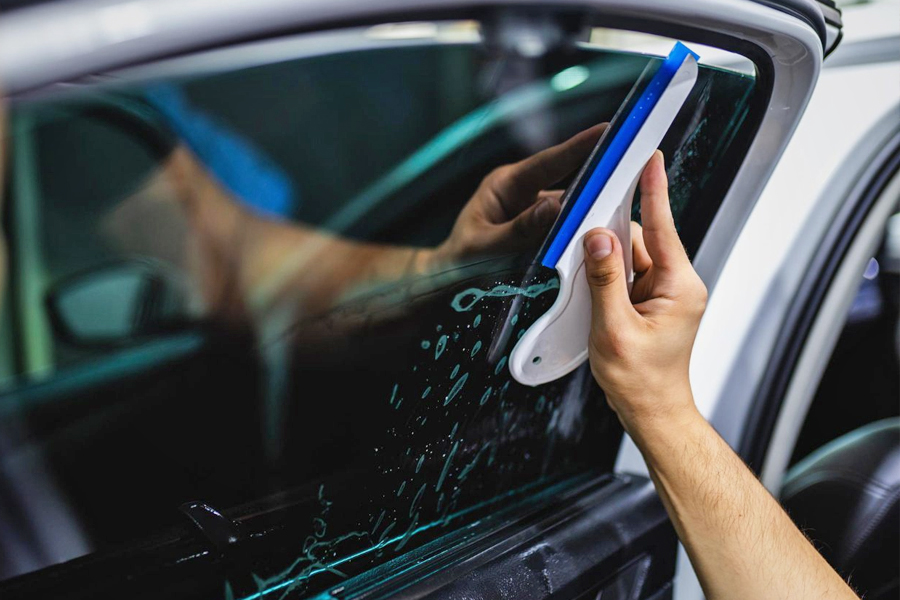A Comprehensive Overview to Recognizing Car Home Window Tint and Its Advantages
Vehicle home window tinting serves greater than just a visual function for vehicles. It supplies different types, each with distinctive features and advantages. Comprehending these choices, along with legal regulations and upkeep ideas, is essential for any lorry proprietor. The advantages might substantially boost driving convenience and car long life. As one explores the subtleties of window tinting, the concern occurs: what kind of color is best suited for private requirements?
Comprehending Automobile Window Color: What It Is and Exactly how It Functions
Auto home window color serves as a protective barrier that enhances lorry appearances while providing practical advantages. This slim film is used to the interior surface area of cars and truck windows, lowering glow and obstructing harmful ultraviolet (UV) rays from the sunlight. By filtering sunshine, car window color helps to control the indoor temperature level of the car, bring about boosted convenience for guests and reduced dependence on air conditioning.Additionally, it protects the automobile's interior from fading, protecting both upholstery and dashboard products. The tint can likewise improve privacy, making it harder for outsiders to see inside the automobile. Particular kinds of home window color can boost safety and security; in the occasion of a mishap, the film aids hold destroyed glass with each other, reducing the risk of injury from flying shards. In general, vehicle home window color offers both aesthetic and practical purposes, making it a prominent selection amongst car owners.
Kinds Of Home Window Tint: A Summary of Options
When thinking about window color choices, several kinds are offered, each with distinct characteristics. Colored, metalized, and ceramic home window tints use differing levels of warm denial, UV security, and aesthetic appeal. Understanding these differences can help lorry proprietors make educated selections based upon their preferences and needs.
Dyed Window Tint
Colored window tint represents a preferred choice amongst vehicle owners looking for a effective and inexpensive method to boost their car's looks and privacy. This type of color is developed by putting a layer of color between a safety finishing and an adhesive layer, causing a dark appearance that lowers glare and boosts visual convenience. While dyed home window tint properly blocks harmful UV rays, it might not supply the same level of warm rejection as various other color kinds. Additionally, its color can fade gradually, possibly decreasing its efficiency. Regardless of these downsides, dyed window color remains popular for its cost-effectiveness and capacity to provide a streamlined, stylish aim to numerous vehicle versions.
Metalized Home Window Color
Metalized home window tint provides a balance of style and capability, making it a preferred selection amongst auto proprietors. This sort of color integrates metal particles within the film, enhancing both aesthetic appeal and heat being rejected. The reflective high quality of metalized color helps to decrease glare and improve privacy, while likewise giving UV defense, which safeguards the automobile's inside. In addition, metalized home window color can strengthen window toughness, possibly preventing smashing throughout crashes. Nonetheless, it is vital to keep in mind that the metal elements can disrupt electronic signals, such as GPS and cellular phone reception. Overall, metalized window color supplies an efficient service for those seeking a mix of sunlight, appearance, and sturdiness protection for their vehicles.
Ceramic Window Tint
Ceramic home window tint stands for a sophisticated option in the range of vehicle window movies, offering unique benefits over conventional colors. Unlike colored or metalized films, ceramic tints make use of advanced ceramic bits, which effectively decline warm and UV rays without compromising exposure. This technology guarantees that lorries stay cooler, lowering dependence on a/c and enhancing fuel performance. Furthermore, ceramic home window colors are much less most likely to disrupt electronic devices, such as general practitioner or mobile signals, making them a useful option for modern automobiles. Furthermore, their toughness and scratch resistance contribute to a much longer lifespan compared to other sorts of tints. In general, ceramic window color provides superior efficiency, comfort, and security, making it a recommended option for discerning car proprietors.
Advantages of Auto Home Window Color: Beyond Aesthetic Appeals
While numerous people associate auto window tint with enhanced design, its benefits expand much past plain visual appeals. One significant advantage is warmth decrease; home window color can block up to 99% of hazardous UV rays, securing and keeping the interior cooler furniture from fading. This not just improves comfort during hot weather but also minimizes dependence on cooling, bring about boosted gas efficiency.In addition, car window tint provides an included layer of personal privacy and security. Tinted home windows make it tough for outsiders to see inside the car, which can deter burglary and secure belongings. In addition, lots of tints enhance the glass, decreasing the chance of smashing in the occasion of a mishap, therefore boosting safety.In enhancement to these useful benefits, auto window color can likewise add to glow decrease, boosting visibility for vehicle drivers and guests alike. This complex approach to convenience and security makes window tint a useful investment for car owners.
Lawful Considerations: Tinting Rules by State
Prior to dedicating to vehicle window color, car proprietors need to browse a complicated landscape of tinting laws that differ by state. Each state has you can try this out certain legislations controling the allowable levels of color darkness and reflectivity for different windows, consisting of windshields, front side home windows, and back home windows. These laws often include visible light transmission (VLT) portions, which determine how much light can pass with the colored glass.Some states allow darker colors on back home windows while limiting front side and windshield tints for security factors. Additionally, certain states might call for a certification from the producer to confirm conformity with tinting laws. Breaking these guidelines can lead to penalties, required elimination of the tint, or both. It is important for car proprietors to investigate their state's regulations completely to guarantee lawful conformity prior to mounting home window color. This persistance can conserve time and cash over time.
Picking the Right Tint: Factors to Consider
When picking the appropriate home window color for a vehicle, several vital factors enter play. Tint darkness levels, UV defense rankings, and conformity with legal policies are vital considerations to guarantee both visual appeals and performance. Reviewing these aspects will certainly help people make an enlightened choice that meets their needs and sticks to regional laws.
Tint Darkness Degrees
Picking the ideal color darkness level is necessary for accomplishing the desired equilibrium between visual appeals and performance in car window tinting. Various states have varying lawful guidelines concerning tint darkness, which can influence the option. Generally, colors are measured in percentages, with lower percentages showing darker shades. Darker colors provide boosted privacy and a streamlined appearance yet can minimize presence, especially in the evening. Conversely, lighter colors maintain an even more open feeling, making certain appropriate visibility while still supplying some warmth and glare reduction. When making a choice, individuals should consider their driving routines, local legislations, and individual choices. Eventually, the appropriate color darkness level boosts the vehicle's appearance while ensuring safety and security and compliance with legal standards.
UV Defense Score
Color darkness levels play a significant function in the overall performance of car window tinting, but one more important aspect to examine is the UV protection rating of the chosen tint. This ranking suggests the portion of unsafe ultraviolet rays that the color can block. Premium colors typically offer 99% or even more UV security, securing travelers and the automobile's interior from sun damage. Davinci of Michigan. Extended direct exposure to UV rays can bring about skin troubles and fading of furniture, making a high UV defense ranking important for health and wellness and longevity. When choosing window color, customers need to prioritize imp source this score along with darkness degrees to ensure optimum comfort and safety while driving. Recognizing these elements help in making an informed choice when purchasing automobile window tinting
Lawful Rules Conformity
Comprehending neighborhood lawful laws is crucial for anybody thinking about car window tinting. Each state or area has particular regulations governing the allowed levels of color darkness and reflectivity for different home windows. These policies often define the noticeable light transmission portion, figuring out how much light can pass through the colored glass. Non-compliance can cause penalties, required elimination of the tint, or problems during car assessments. Additionally, some areas might have restrictions on the usage of certain tinting products, requiring customers to choose items that meet safety and security requirements. It is crucial for automobile owners to investigate their local regulations thoroughly before picking home window tint to assure conformity and prevent possible lawful issues.

Installment Process: DIY vs. Expert Services
How does one decide between a DIY installment and working with professional services for car window tinting? The choice typically depends upon budget, experience, and desired results. A do it yourself approach can be cost-effective, allowing people to save on labor expenses. Nevertheless, it requires a certain level of skill and knowledge concerning the tinting process. Those who are precise and person might locate success with DIY sets readily available in the market.Conversely, professional services offer knowledge and top notch materials, guaranteeing a flawless coating. Experts typically guarantee their job, supplying comfort against potential concerns such as peeling off or bubbling. In addition, they are familiar with local regulations relating to tinting, which can be complex for the ordinary cars and truck owner.Ultimately, the decision reflects an equilibrium between cost, individual capability, and the anticipated their explanation high quality of the tinting work. Each choice has its benefits, and the very best choice depends upon private situations and preferences.
Maintenance Tips: Maintaining Your Tint in Top Problem

Frequently Asked Concerns
For How Long Does Window Color Typically Last on a Vehicle?
Home window tint typically lasts between five to 10 years, depending on factors such as high quality, application, and environmental conditions. Normal upkeep and proper treatment can extend its life-span, guaranteeing perfect performance and appearance with time.
Can Window Tinting Damages My Automobile's Original Glass?
Home window tinting, when applied correctly, does not harm a cars and truck's original glass. However, incorrect installation or low-grade materials might lead to concerns like peeling or gurgling, possibly impacting the glass's honesty gradually.
Is Home Window Tinting Safe for All Kinds Of Vehicles?
Window tinting is normally safe for many automobiles, gave the film follows regional laws and is correctly applied. Nonetheless, some customized cars might call for specific considerations, making it necessary to speak with experts prior to installment.
Will Window Tinting Gap My Cars And Truck Warranty?
The question of whether home window tinting spaces an automobile guarantee typically relies on the maker's plans. Normally, if the tint does not damage the car, guarantees normally continue to be undamaged. Seeking advice from the dealer is recommended.
Can I Remove Window Tint Myself if Needed?
Removing window tint oneself is feasible, but it calls for cautious attention to avoid harming the glass. People ought to use ideal devices and techniques to guarantee an effective removal without leaving adhesive deposit or scratches behind. While colored window color properly blocks harmful UV rays, it may not offer the same degree of heat rejection as various other color kinds. Ceramic home window color stands for an innovative choice in the spectrum of automobile home window films, offering distinctive advantages over typical tints. Before dedicating to car home window color, automobile owners need to navigate a complicated landscape of tinting regulations that differ by state. These regulations commonly include noticeable light transmission (VLT) percents, which dictate just how much light can pass through the tinted glass.Some states allow darker tints on rear windows while restricting front side and windscreen tints for safety and security reasons. Color darkness levels play a substantial role in the overall performance of auto window tinting, however another important variable to examine is the UV protection score of the selected color.